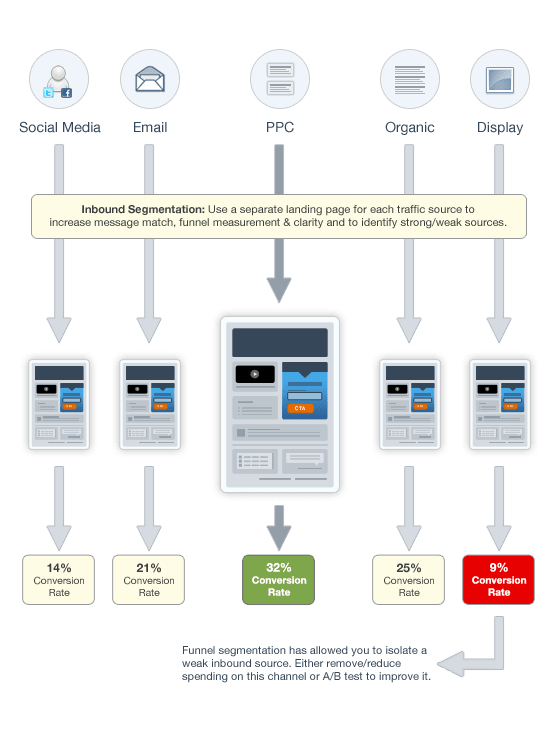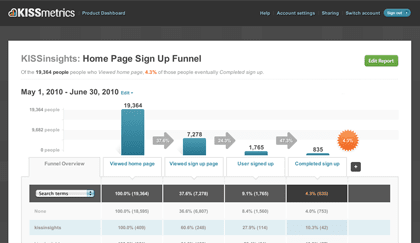Reporting on the success (or failure) of your marketing campaigns is a massive pain. I’d rather stick a pitchfork in my ankle than wait for a monthly report from an IT department, or sit through a 30-slide presentation of Google Analytics charts by a business analyst. And it’s only getting worse now that the concept of multiple inbound marketing channels has reached the mainstream (which is a great thing btw).
Marketers are using more sources for driving traffic than ever and it’s causing funnel gridlock. Sending up to 7 different traffic sources into the same page (hopefully you’re using landing pages and not your homepage) makes it impossible to know what’s working and what isn’t.
So how do you figure out which traffic sources are performing and where best to focus your marketing efforts?
Funnel Segmentation: The Answer to Your Measurement Woes
Consider the configuration presented below. Notice how each inbound source uses it’s own landing page. It’s super simple and will make your headache go away. Read on to learn about the benefits of segmenting to separate landing pages.

The Benefits of Segmentation and Landing Pages
There are 4 key benefits to segmenting your inbound traffic using landing pages:
- Message match: By teaming up each upstream ad source with it’s own landing page, you’ll get a much stronger message match. Each source will have different types of communication (an email is very different to a 140 character tweet). For PPC this will help you get a lower cost per click (CPC) due to an improved quality score. Message match is a critical factor in reducing bounce rate (a poorly matched message confuses people and makes them dance all over your back button).
- Clarity of reporting: Imagine a report that had 5 numbers. Representing the conversion rate of each inbound marketing channel. You would be able to see immediately what’s working and what’s not, which leads into my next point…
- Accountability: Nobody should have to ride a three-legged donkey. But that’s what you are doing by throwing time and money at an under-performing traffic source. By segmenting the traffic, the experience and the results, you can make your teams or yourself more accountable. Transparency is a wonderful motivational tool. If a channel isn’t working, can it – or better yet, do some A/B testing to optimize for higher conversion rates. Which segues nicely to my final point…
- Freedom to test: It’s true that you could measure the performance of multiple streams even if you are using a single target page (like your homepage). But even if you manage to sit through that boring meeting and that awful PowerPoint presentation – you would be faced with a scenario where one or more of your channels isn’t working as well as expected. Now what? You’re in deep poop really, ’cause if you try to optimize your page to improve your social media traffic, your email and PPC traffic will start seeing unpredictable side effects.
By using separate landing pages for each funnel, you are free to test and optimize to your heart’s content. This lets you empower your different inbound marketing team members (the email guy can run his own show – as can the social media girl) to improve their own area without interfering with or interference from the other channels. It can also build a fun and competitive “which funnel is best” type environment.
Brilliant.
Visualizing & Measuring the Funnel
A quick note on visualizing and measuring your funnels. The simplest way I’ve found is to use a tool call KISS Metrics – it’s been designed for funnel analysis and as the name implies it’s really simple.

Removing all the extraneous and overcomplicated information of many analytics programs and letting you worry about real marketing metrics.
